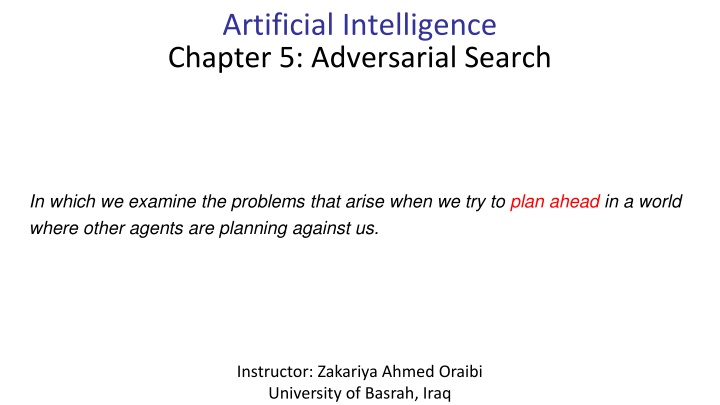
Adversarial Search in Competitive Environments: A Deep Dive
Delve into the world of adversarial search in competitive environments where agents strategize against each other, focusing on zero-sum games like chess. Explore game setup, minimax strategy, and the challenges of decision-making in adversarial settings.
Download Presentation

Please find below an Image/Link to download the presentation.
The content on the website is provided AS IS for your information and personal use only. It may not be sold, licensed, or shared on other websites without obtaining consent from the author. If you encounter any issues during the download, it is possible that the publisher has removed the file from their server.
You are allowed to download the files provided on this website for personal or commercial use, subject to the condition that they are used lawfully. All files are the property of their respective owners.
The content on the website is provided AS IS for your information and personal use only. It may not be sold, licensed, or shared on other websites without obtaining consent from the author.
E N D
Presentation Transcript
Artificial Intelligence Chapter 5: Adversarial Search In which we examine the problems that arise when we try to plan ahead in a world where other agents are planning against us. Instructor: Zakariya Ahmed Oraibi University of Basrah, Iraq
Adversarial Search - Games are competitive environments where agents goals are in conflict. In this chapter, we will focus on zero-sum games. Such as chess. - This means, deterministic, fully observable environments in which two agents act alternately. For example, if one player wins a game of chess, the other player necessarily loses. It is this opposition between the agents utility functions that makes the situation adversarial. - Adversarial Search also referred to as Games. - In chess, we plan ahead and the other agent is planning against us.
Adversarial Search - The state of a game is easy to represent, and agents are usually restricted to a small number of actions whose outcomes are defined by precise rules. - Physical games, such as ice hockey, have much more complicated descriptions, a much larger range of possible actions, and rather imprecise rules defining the legality of actions.. - Why it s interesting to studyGames? In chess, the search tree has about 35100 or 10154 nodes. - - Games are like real world problems, they require decisions to be made.
Adversarial Search Assumptions: - Two agents whose actions alternate. - Fully observable environment. Difference between Search and Adversary: - In adversary (games) we use strategy, while in search we use heuristic. - In games, optimality depends on opponents. - In search, the evaluation function involves estimating the cost from start to end.
Adversarial Search Example: Game Setup - Two players: Max and Min. - Max moves first and they take turn until game is over. Game as Search - Initial state: e.g. board configuration of the chess. - Successor function: list of (move, state) pairs legal moves. - Terminal test: is the game finished? - Utility function: +1 (winner), -1 looser.
Adversarial Search tic-tac-toe game tree Minmax Strategy: Max wants to Maximize the utility function. While, Min wants to Minimize it. Complete Depth-First Search of the game tree. Assumption: Both players play optimally.
Adversarial Search Max Nodes Min Nodes What are the values for Max and Min nodes?
Adversarial Search Max Nodes Min Nodes 3 What are the values for Max and Min nodes?
Adversarial Search Max Nodes Min Nodes 3 2 What are the values for Max and Min nodes?
Adversarial Search Max Nodes Min Nodes 3 2 2 What are the values for Max and Min nodes?
Adversarial Search Max Nodes Min Nodes 3 3 2 2 What are the values for Max and Min nodes?
Adversarial Search Max Nodes Min Nodes A1 A11 A1 is the best choice for Max A11 is the best choice for Min
Adversarial Search Problems with MinMax Search: * Number of states is exponential Solution: Don t examine every node. Use Pruning. Remove branches that don t influence the final decision.
Adversarial Search Alpha-Beta Algorithm: Depth-first search only considers nodes along a single path. = highest value choice that we can guarantee for MAX. = lowest value choice that we can guarantee for MIN. Update values for both and during search and prune remaining branches as soon as the value is known to be worse than current and for both MAX and MIN.
Adversarial Search: Alpha-Beta Algorithm Example: [Max = - , Min = + ] Which branches will be pruned?
Adversarial Search: Alpha-Beta Algorithm Example: [Max = - , Min = + ] Which branches will be pruned?
Adversarial Search: Alpha-Beta Algorithm Example: [Max = - , Min = + ] Which branches will be pruned?
Adversarial Search: Alpha-Beta Algorithm Example: [Max = - , Min = + ] Which branches will be pruned?
Adversarial Search: Alpha-Beta Algorithm Example: [Max = - , Min = + ] Which branches will be pruned?
Adversarial Search: Alpha-Beta Algorithm Example: [Max = - , Min = + ] Which branches will be pruned?
